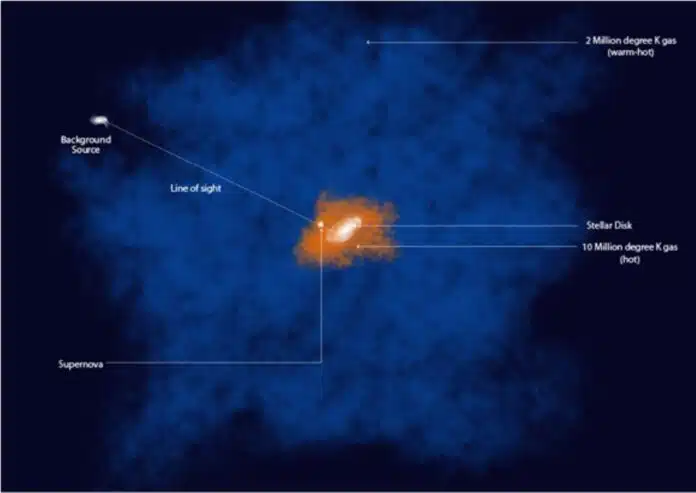
By Amit Malewar 22 Nov, 2024
Collected at: https://www.techexplorist.com/scientists-unveiled-veil-fiery-gas-disc-milky-way/93269/
Our galaxy, the Milky Way, contains more gas than stars, and this abundant gas is the primary source of star formation. However, its diffuse nature makes it challenging for astronomers to observe and measure the gas.
Decades ago, studies revealed that the Milky Way is surrounded by a massive gas sphere heated to a few million degrees Kelvin, extending up to 700,000 light years. This heat is thought to result from the galaxy’s gravity, causing atoms to move rapidly to avoid being pulled in.
More recently, scientists discovered even hotter gas, reaching around ten million degrees Kelvin, evidenced by faint X-ray emissions across the galaxy and its presence in the spectra of distant quasars.
A new area of research has emerged as astronomers try to identify the sources responsible for heating and sustaining the scorching gas surrounding the Milky Way. In collaboration with IIT-Palakkad and Ohio State University, Raman Research Institute (RRI) scientists have proposed a model to explain this mysterious source in two related studies.
Their findings confirm that the gas responsible for emitting and absorbing X-rays detected by astronomers differs. The X-ray emitting gas originates from a puffed-up region around the Milky Way’s stellar disk.
This hot gas is heated by the explosions of massive stars in the disk, which occur due to ongoing star formation. These supernovae raise the gas temperature to extreme levels.
Mukesh Singh Bisht, PhD student at RRI, said, “As “uch, explosions keep heating the gas floating around the disc of the Milky Way, and they enrich the gaseous matter with elements synthesized within massive stars.”
The turbulent gas surrounding the Milky Way’s disc is either swept into the surrounding medium or cools and falls back onto the disc as it swirls violently. In absorption studies, astronomers were surprised by the gas’s extremely high temperatures and its elemental composition.
The gas was found to be enriched with α-elements, which are vital building blocks of heavier elements in the universe. This discovery added a new layer of complexity to understanding the gas surrounding the galaxy.
Biman Nath, faculty at RRI and one of the contributory authors in both papers, said, “This fiery gas, at least in a few directions, seems to be enriched with large quantities of α-elements, such as Sulphur, Magnesium, neon, etc., whose nuclei are nothing but multiples of Helium nuclei. This is a vital clue of nuclear reactions occurring within the stellar core. These elements are thrown out of massive stars during supernovae explosions.”
While thousands of run-away stars are ejected from the Milky Way’s disc, those that explode as supernovae above the disc could generate puffed-up, α-enriched gas. If these supernovae align with the light from distant quasars, the atoms in the hot gas will absorb the quasar’s light, creating shadow signals that explain the observed absorbing gas.
Meanwhile, a fiery veil of hot gas surrounds the Milky Way’s disc, continuously fueled by ongoing star formation in the stellar disc. As Bisht, one of the researchers involved in the study, stated, this explains the X-ray emission from the hot gas.
Journal Reference:
- Mukesh Singh Bisht et al. On the Origin of the 107 K Hot Emitting Gas in the Circumgalactic Medium of the Milky Way. The Astrophysical Journal. DOI 10.3847/1538-4357/ad77c0

Leave a Reply